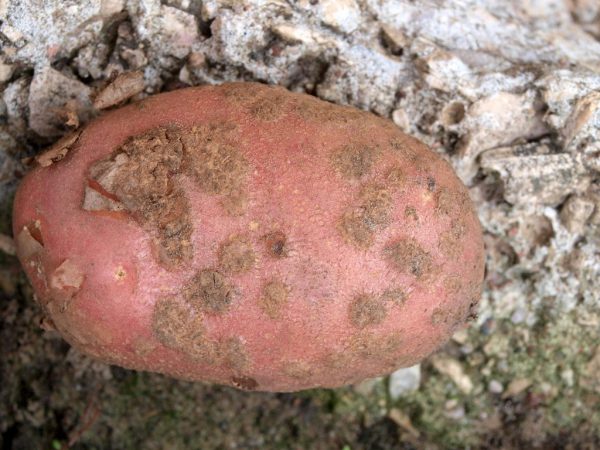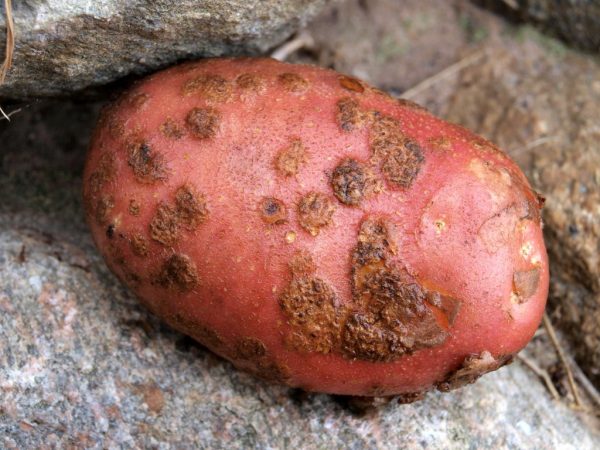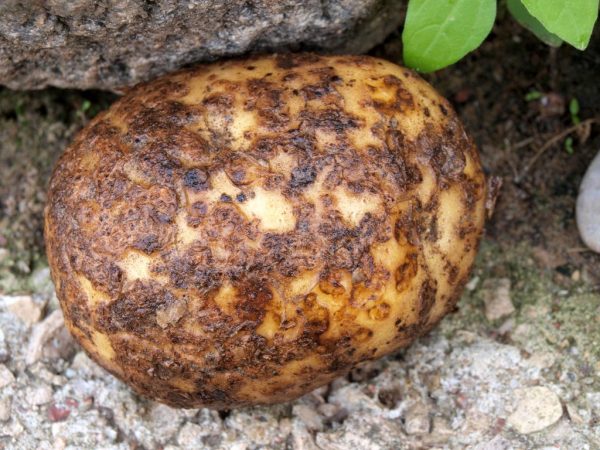Potato scab and methods of dealing with it
Potato scab is often mistakenly considered the most harmless disease among gardeners. She lacks the initial external signs of the development of the disease. Some varieties of potato scab do not manifest themselves in any way at the initial stage. The whole danger of the disease lies in the fact that the infection accumulates in the soil and, year after year, reduces the quantitative indicators of the potato crop.
- Types of scab
- Reasons for infection
- Scab harm
- Common potato scab
- Signs
- Spread
- Prevention and treatment
- Powdery Potato Scab
- Signs
- Spread
- Prevention and treatment
- Black potato scab
- Signs
- Spread
- Treatment and prevention
- Silver potato scab
- Signs
- Spread
- Treatment and prevention
- General control measures
- Agrotechnics
- Fertilizers
- Drugs

Potato scab and methods of dealing with it
Types of scab
The causative agents of potato scab are fungi and, depending on their type, there are several types of fungal diseases of vegetable crops:
- ordinary,
- black, or rhizoctoniasis,
- powdery,
- silvery.
Reasons for infection
Among the main reasons contributing to the appearance of the fungus:
- scab fungus on healthy potato tubers from contaminated soil,
- purchase of infected planting root crops,
- violation of crop rotation and planting a vegetable crop in the same planting site,
- exceeding the standard for the content of the nitrogen component in the ground,
- an increase in the temperature of the soil above 20 ° С,
- weak acidity of the soil layer,
- non-observance of the rules for fertilizing the earth with organic matter - manure and compost.
Scab harm
Scab on potatoes does not pose a threat to human health, however, vegetables that can be eaten lose their nutritional value: compared to healthy tubers, their starch content is halved.
Affected potato tubers are poorly preserved due to the intensive development of rot in them. Infected root crops preserved during the winter period cannot be used as planting material. It is forbidden to plant them in the ground, as they act as sources of soil contamination. As a result, an unhealthy potato crop will be obtained, and a fungus will settle in the soil.
Common potato scab
Common scab is considered a common fungal infection in potato beds. Its fungal pathogen Streptomyces scabies prefers to settle in dry sandy subsoil with a low to medium acidity level and is active at temperatures ranging from 25 ° C to 28 ° C.
Signs
Among the main features characteristic of ordinary potato scab:
- small brown lesions, sometimes with shades of red or purple,
- rough surface of potato tubers,
- the appearance of slightly noticeable mesh grooves on root crops.
In cases of severe infection of potato tubers, the lesions increase in size and subsequently begin to harden and crack. The result of the process is the rotting of vegetables.
Spread
The common variety of the fungus practically does not damage other parts of the potato bush, spreading mainly along the tubers. During storage at low temperatures in basements, the common scab fungus falls into a suspended state, but does not die, which saves the harvested and stored crop until spring.
The most susceptible to the common variety are potato varieties with a thin red skin.
Contributing factors for the development of the fungus are:
- insufficient watering
- fertilizing the land with raw, not yet rotted manure,
- the introduction of an excessive amount of limestone.
Prevention and treatment

You can fight scab
Against ordinary scab on potatoes, they treat the land intended for planting a vegetable crop. In addition, gardeners are trying to plant varieties resistant to fungus, which include Kameraz, Domodedovsky, Yantarny, Priekulsky, Zarechny.
As a preventive measure, how to deal with scab on potatoes, it is recommended to spray planting tubers with drugs such as polycarbacin or nitrafen. An effective method of prevention for the development of immunity against the fungus will be the germination of seedlings in sunlight. Potato seedlings should be watered immediately after they are planted in the ground and watering should be finished when the stem reaches a width of 1.5-2.0 cm.
Powdery Potato Scab
Unlike the common fungus species, which prefers dry soil, powdery scab is a consequence of the action of the pathogen Spongospora subterranean. The fungus settles in waterlogged soil and is able to maintain its activity for up to five years. The optimal conditions for its appearance are considered to be temperature ranges from 10 ° С - 12 ° С.
Signs
Among the main external symptoms of the description of the disease, characteristic of the powdery variety:
- covering the stems with white growths,
- the appearance on potato roots of multiple red-brown wart neoplasms of various sizes.
Spread
Powdery scab affects both tubers and plant stems, mainly their lower part. fungal pathogens are transmitted through organic residues preserved in the soil, but they can also be spread by air. Damaged tubers usually dry out during storage, but with high humidity in the room they begin to rot.
The factors contributing to the spread of the powdery form of the disease are rains.
Prevention and treatment
Among the potato varieties resistant to this type of fungal disease are Cardinal, Majestic, Yubel. In order to prevent powdery fungus, gardeners often keep the grown seedlings before planting in soil in formalin solution for 5-7 minutes, then covering them with tarpaulin for several hours.
Black potato scab
The causative agent of black potato scab is the fungus Rhizoctonia solani, which is activated at temperatures from 16 ° C to 18 ° C. He prefers high humidity, the values of which are in the order of 80-100%. The fungus develops in loamy soil.
Signs
The main signs of damage to a vegetable crop by a black variety are black or dark brown lesion spots that appear on the surface of root crops. Over time, they merge into large foci. Often, inexperienced gardeners mistake the black form of a fungal disease for soil dirt. Infected seedlings develop with curled leaves.
Spread

Disease can kill an entire crop
Black scab of potatoes, or rhizoctonia, is the most dangerous form, affecting the entire potato bush. The tubers, stems and foliage of potatoes suffer from the black variety of fungal disease. The fungus develops with a rapid intensity, is able to penetrate into the potato tuber already at the germination stage, dooming the future crop to death.
Among the factors contributing to the spread of the disease is a cold rainy period in late spring time.
Treatment and prevention
Varieties resistant to the black variety have not been bred. Given the serious damage from this fungal disease, chemical preparations are often used in the fight against it. As a preventive measure, gardeners use the processing of tubers with the help of Integral, Vitavax or Baktofit. As an agrotechnical measure, it is recommended to plant a vegetable crop to a depth of no more than 7 cm in sandy loam soil, no deeper than 12 cm in peat and no more than 11 cm in loamy soil. Landing in a ground warmed up to at least 8 ° C will be a preventive measure. Organic fertilizers and in excess of the usual amount help to prevent the black variety of the disease. Reviews of gardeners recommend using copper sulphate in the fight against the black variety of fungal disease, which is required to spray the bushes.
Silver potato scab
The causative agent of the silvery variety is the Helminthosporium solani fungus, which is able to maintain its vital activity at temperatures dropping to 3 ° C. The fungus settles on any soil - loamy or sandy loam, when the humidity reaches 80-100%.
Signs
Among the main external signs of a silvery scab of a potato are spots on potato tubers with a silvery tint, which occupy up to 40% of the surface of the root crop. Initially, lesions of a black sooty color flake off, turning gray, and the affected vegetables begin to dry out and wrinkle, decreasing in size.
Spread
The fungal disease spreads at the stage of flowering of a vegetable crop and during the formation of root crops. The silver scab of potatoes, which retains its activity even at low temperatures, affects healthy tubers during storage, leading to losses of the harvested crop up to 40%.
Treatment and prevention
Preventive treatment of harvested potato tubers is carried out using chemical treatment of vegetables before storing them with Nitrafen or Botran.
General control measures
Each of the considered types of fungal disease has its own pathogen, however, in the fight against them, general measures of prevention and treatment are used.
Agrotechnics
Among the methods of how to deal with scab on potatoes and get rid of it, the central place among all methods is occupied by the correct crop rotation, which assumes that the vegetable crop changes its place of planting annually, and vegetables do not plant on the soil contaminated with fungus for at least 4-5 years ... This period is enough for the fungus to die. It is forbidden to grow on contaminated land and other crops susceptible to fungal disease - carrots, peppers, tomatoes, eggplants, beets. Vegetable gardens achieve positive results by alternating different varieties of potato plantings with plantings of onions or legumes.
Disease outbreaks are caused by fresh manure applied to the soil.
Planting green manures is used as a treatment for infected land, among which legumes, cereals and mustard help most often to treat the soil. The green manures that have reached a height of 10-15 cm are dug up together with the ground. The remains of green manure found in it will act as a source of the appearance of saprophytic fungi and bacteria, which are natural enemies of scab fungi, which helps to cure the infected soil.
Fertilizers
Scab, especially the common variety, develops in alkaline soil, therefore fertilizing the earth with manganese and boron before planting potatoes will become a barrier to the development of a fungal disease. The fertilizer rate per 100 square meters will be:
- ammonium sulfate - 1.5kg,
- superphosphate - 2.0 kg,
- potassium magnesium - from 2.5 to 3.0 kg,
- sulphate copper - 40g,
- manganese - 20g
- boric acid - 20g.
Drugs
Treatment and prevention measures are directly related to the treatment of vegetable crops with fungicides. It is recommended to pickle vegetable crops before planting tubers. Most often, gardeners also use Maxim, Fito plus and Fitosporin, which also help against phytophthora. The last fungicide can be used to treat seed potatoes and bushes planted in the ground at least 3 times during the growing season.
Less strong chemical measures can be used against the common variety. It is enough to treat the tubers before planting with a growth regulator, for example, Zircon.
To get rid of the fungus on potatoes, the stronger Fenoras and Mancozeb help. Their application is carried out before planting.

